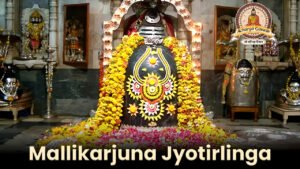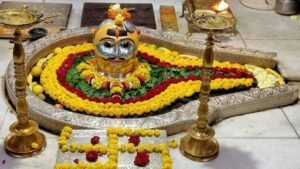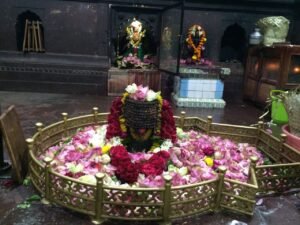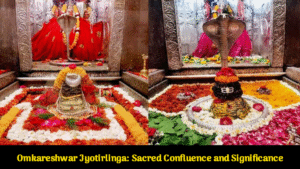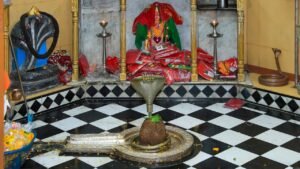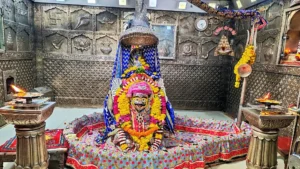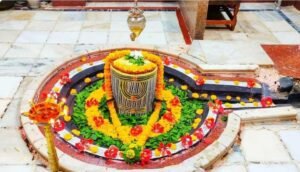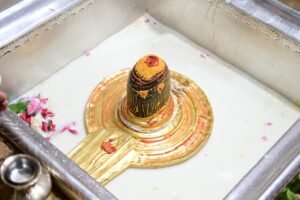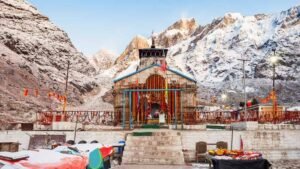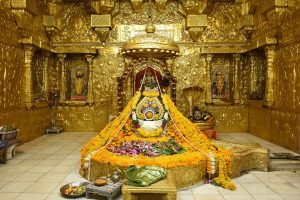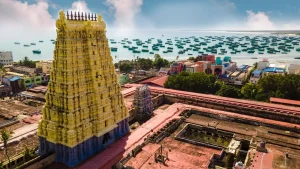12 jyotirling
12 Jyotilings
द्वादश ज्योतिर्लिंगानि
सौराष्ट्रे सोमनाथं च श्रीशैले मल्लिकार्जुनम्।
उज्जयिन्यां महाकालमोङ्कारममलेश्वरम्॥
परल्यां वैद्यनाथं च डाकिन्यां भीमशङ्करम्।
सेतुबन्धे तु रामेशं नागेशं दारुकावने॥
वाराणस्यां तु विश्वेशं त्र्यम्बकं गौतमीतटे।
हिमालये तु केदारं घुश्मेशं च शिवालये॥
This classical verse lists the Jyotirlingas: Somnath (Saurashtra), Mallikarjuna (Shrishaila), Mahakaleshwar (Ujjain), Omkareshwar (Mamleshwar), Vaidyanath (Parali), Bhimashankar (Dakini), Rameshwar (Setubandha), Nageshwar (Darukavan), Vishwanath (Varanasi), Trimbakeshwar (Gautami banks), Kedarnath (Himalayas), Grishneshwar (Shivalaya)
The meaning of the Dwadash Jyotirlinga Stotra is a veneration of the twelve most sacred Shiva shrines, each celebrated for its unique spiritual power and history. The hymn lists the locations and names of these shrines, invoking the blessings of Lord Shiva at each site:
Somanath in Saurashtra is revered for Lord Shiva’s brilliance and his role as a giver of devotion and mercy.
Mallikarjuna (Shrishailam) is saluted as a bridge across the ocean of samsara (life’s turmoil), offering liberation to devotees.
Mahakaleshwar of Ujjain and Omkareshwar of Amleshwar are honored for their life-giving attributes and spiritual majesty.
Vaidyanath (Parali) is praised for healing powers, while Bhimashankar (Dakini region) offers protection from evil.
Rameshwar (near the Setu bridge), and Nageshwar (Daruka forest) are sanctuaries bestowing peace and fearlessness.
Vishwanath in Varanasi is worshipped for granting happiness and destroying accumulated sins; Trimbakeshwar (on banks of river Gautami) stands as a source of purity.
Kedarnath in the Himalayas and Grishneshwar in Shivalaya conclude the list, representing the supreme kindness and grace of Shiva.
The stotra promises that those who remember, recite, or meditate upon these twelve Jyotirlingas every morning and evening are freed from the sins of seven past births, find their wishes fulfilled, and are blessed by Shiva’s grace

The twelve Jyotirlingas are the most sacred shrines dedicated to Lord Shiva, symbolizing his infinite light and divine presence in Hindu tradition. Each Jyotirlinga marks a place where it is believed Shiva appeared as a radiant column of light, revealing his supremacy during a legendary debate between deities Brahma and Vishnu. Devotees undertake pilgrimages to these shrines from across the country, seeking spiritual growth, the cleansing of sins, and divine blessings often described in the “Dwadash Jyotirlinga Stotra”.
Each Jyotirlinga, housed in ancient temples, represents a different manifestation and aspect of Shiva. They are spread across India—significant ones include Somnath in Gujarat, Mallikarjuna at Srisailam in Andhra Pradesh, Mahakaleshwar in Ujjain (Madhya Pradesh), Omkareshwar in Madhya Pradesh, Kedarnath in Uttarakhand, Bhimashankar in Maharashtra, Kashi Vishwanath in Varanasi (Uttar Pradesh), Triambakeshwar in Maharashtra, Vaidyanath in Jharkhand, Nageshwar in Gujarat, Rameshwar in Tamil Nadu, and Grishneshwar in Maharashtra. Each location is closely linked to a unique legend or historical tale emphasizing Shiva’s miraculous powers and compassionate nature.
The Jyotirlinga pilgrimage is more than a religious journey—it’s a transformative experience that binds devotees to the cultural and spiritual heritage of India. Visiting these shrines is believed to confer deep spiritual merit and foster inner peace, as well as connect pilgrims with the cosmic energies of zodiac signs and planets. Together, the twelve Jyotirlingas express the unity and omnipresence of Shiva, revered for centuries as the eternal spirit and destroyer of evil.
The history and significance of the Jyotirlingas trace back to ancient Hindu mythology, specifically the Shiva Purana. Each Jyotirlinga not only represents Shiva’s unique manifestation but is also tied to mythic episodes, such as his appearance as a boundless pillar of light to settle disputes regarding cosmic supremacy. Legends recount Shiva’s infinite power, and each shrine’s origin story is celebrated in sacred texts and local folklore—adding a rich tapestry of meaning to each temple’s existence.
Culturally, the Jyotirlinga temples are masterpieces of Indian architecture and are often located in places of breathtaking natural beauty, from Himalayan peaks (Kedarnath) to riverside locations (Omkareshwar, Kashi Vishwanath), underscoring Shiva’s presence in nature. Most temples have withstood centuries of historical challenges—such as the repeated destruction and rebuilding of Somnath in Gujarat—demonstrating the enduring faith and resilience of their devotees. Festivals, aartis, and unique rituals at each site reflect local traditions and the unity of Indian spiritual culture.
Pilgrimage to the Jyotirlingas is believed to offer spiritual liberation and freedom from cycles of karma. Each temple attracts thousands of pilgrims during Hindu holy months, creating vibrant spiritual communities that carry forward the legacy of devotion and self-realization attributed to Lord Shiva. The Jyotirlingas thus act as bridges between myth, faith, and everyday life, embodying both the mystical and transformative aspects of Hindu worship.

















































